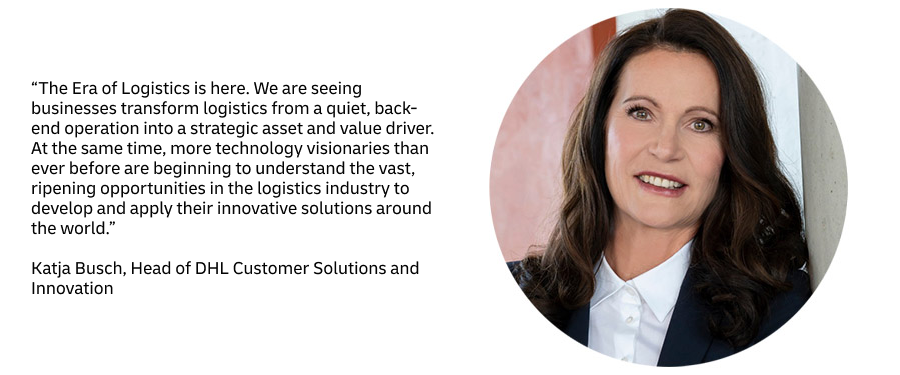Logistics industry trends for 2024

 The Future of the Logistics Industry: 4 trends to watch
The Future of the Logistics Industry: 4 trends to watch
1. Big data to mitigate supply chain risks
Global supply chains often rely on a complex network of different moving parts all working together smoothly. Yet disruptions may come in the form of shortages of raw materials, insolvencies within the supplier network, or shipments stuck at customs. Not to mention worldwide events such as conflicts, inflation and pandemics.
With logistics professionals dealing with more challenges than ever to ship goods, startups selling supply chain tech that can mitigate some of the risks are gaining major investment.
For example, one of the supply chain risk analytics companies taps into predictive analytics and “boots on the ground” in every port in the world to spot disruptions before they become clients’ problems.
Such companies are equipped with a broad view of risk from the component level to materials, through the shelf to the consumer. They combine AI predictions and intelligence-based modeling with expert human analysis and real-world, in-the-moment insights from a global network of partners, which allows them to provide visibility to deliver a complete view of all the variables impacting a company’s supply chain, from back-ups at the ports or labor unrest to weather disruptions – up to 15 days in advance.
This technology means, for example, a client in Germany can anticipate a materials shortage in China in record time, and put alternative measures in place. Getting ahead of such disruptions leads to increased services, reduced freight costs and more on-time deliveries.
As we move into 2024, expect supply chain agility to be something which more and more businesses invest in.
2. Internet of Things for greater supply chain visibility
The Internet of Things refers to a network of physical objects connected to and exchanging data over the internet. Everyday examples include Smart TVs, self-driving cars and fitness trackers.
Within supply chains, the IoT is fast becoming one of the most important tools, creating an ecosystem that harnesses traditionally unconnected assets and objects for better visibility. These connected devices share data to shine a light on every milestone in the supply chain, for more resilience and transparency.
 Smart Labels are an IoT-enabled technology that will transform the logistics sector in the next couple of years. They are upgraded with intelligent inlay technology that can digitally capture and communicate more information than is printed on a physical label.
Smart Labels are an IoT-enabled technology that will transform the logistics sector in the next couple of years. They are upgraded with intelligent inlay technology that can digitally capture and communicate more information than is printed on a physical label.
They may transfer data using quick response (QR) codes or radio frequency identification (RFID) technology, and can be responsive to movement, temperature, touch and environment, capturing data of their surrounding environment using Internet of Things pixels. All of which means complete visibility over the supply chain: faster identification of bottlenecks, improved traceability and inventory management, and protection from counterfeiting. Expect their applications to grow even further as more is invested into the technology over the next few years.
 3. AI in logistics
3. AI in logistics
AI in logistics is an exciting prospect – its potential to transform the industry seemingly knows no bounds. The statistics speak for themselves: research by Accenture found that 36% of large, mid-size, and small businesses have successfully implemented AI for supply chain and logistics processes, whilst 28% were on the verge of doing so. As a result, it’s estimated that AI will boost logistics productivity by more than 20% by 2035.
 AI’s far-reaching scope makes it hard to pinpoint just one or two delivery and logistics trends it will influence in 2024, but here’s a snapshot:
AI’s far-reaching scope makes it hard to pinpoint just one or two delivery and logistics trends it will influence in 2024, but here’s a snapshot:
Computer Vision: this applies artificial intelligence (AI) algorithms to analyze digital photos and videos. Applications include maintaining safety procedures – during the pandemic, for example, the tech ensured workers adhered to social distancing regulations; and inventory management – counting items and sending alerts when it’s time to restock.
Smarter inventory management: not only can AI algorithms help retailers better predict demand – thus avoiding over-or under-stocking products – voice-activated systems will allow them to track stock levels without having to manually scour a spreadsheet.
 4. Logistics sustainability
4. Logistics sustainability
Sustainability has been a growing priority for almost every industry in recent years. Research from KPMG found that more than two-thirds (69%) of CEOs globally have fully embedded environmental, social and governance (ESG) considerations into their business. Despite this, a similar amount (68%) admitted their current progress on ESG is not strong enough to withstand potential scrutiny from stakeholders and shareholders.
Sustainability in logistics covers many areas, but with the spotlight so often shone on transport, it’s no surprise that this is a particular focus for many businesses. With e-commerce, consumers are taking notice, too, with 51% saying that understanding the carbon footprint of their delivery will be “very important” in the next 5 years.
In light of this, some sustainable last-mile solutions your business may wish to consider adopting in 2024 are:
Alternative fuels: DHL Express has recently launched GoGreen Plus, a dedicated solution to help businesses reduce the carbon emissions associated with their shipments through the use of Sustainable Aviation Fuel. This biofuel is produced from renewable sources such as vegetable oils, animal fats, waste products, and agricultural crops. SAF is specifically designed to be used as a substitute for traditional jet fuel and can reduce greenhouse gas emissions by up to 80% compared to fossil fuels.
Electric vehicles: the EV market has grown exponentially over the last couple of years, with sales exceeding 10 million in 2022. Within the e-commerce sector, 15-20% of last-mile cargo fleets have been electrified globally. The technology can help businesses drastically reduce their carbon emissions, save on fuel costs, and win over eco-conscious customers.
Latest trends in logistics: key takeaways
As customer demands and supply chain pressures continue to grow, think about which of the latest innovations in technology, data and AI could transform your business. Logistics insights spanning procurement, inventory management, last-mile delivery and even packaging will help you understand where to invest your resources to remain competitive, resilient and agile in a competitive market. It’s an exciting time for logistics – leverage the opportunity to grow your business!
To start benefiting from some of these innovations today, open DHL Express business account.


